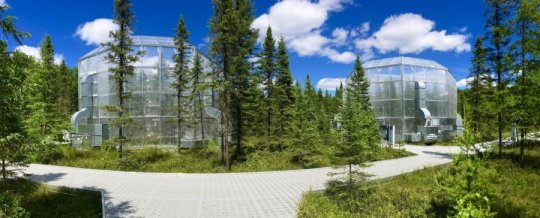[ad_1]
A futuristic experiment simulating warmer environmental conditions has shown that peatland vegetation responds to higher temperatures with an earlier and longer growth period. A study published today in Nature revealed that turning up the heat accelerates spring greening in mature trees, shrubs and mosses and delays fall color change.
The new findings, based on observational data collected at a Department of Energy experimental site, will improve predictive models of environmental change and may have implications for forests around the world.
“This is the first time we’ve been able to confirm the response of vegetation to this range of temperatures, which exceed what can be found in the historical record,” coauthor Andrew Richardson of Northern Arizona University said. “We did not foresee the major role that temperature plays in extending plant activity in the fall.”
The research team used direct observation and digital repeat photography to measure plant greenness over three years at the Spruce and Peatland Responses Under Changing Environments study, a unique ecosystem-scale experiment constructed and operated by DOE’s Oak Ridge National Laboratory.
Previous studies based on historical data indicated that shortened day length was the primary driver of fall changes in plants, with temperature having little impact. The team’s experimental study found, however, that elevated temperatures trigger plant activity even in the fall as exposure to sunlight declines. Plants in the warmest of several study areas, heated 16.2 degrees Fahrenheit above ambient temperature, remained green and functional up to six weeks longer. The warmest vegetation also lost its winter cold protection earlier in the spring, leaving plants vulnerable to leaf and stem damage during a late spring frost in 2016.
Located in the USDA Forest Service’s Marcell Experimental Forest in northern Minnesota, SPRUCE has 10 specially-designed enclosures set at five different temperatures and two elevated levels of carbon dioxide. The site provides scientists with a platform to explore the effects of warmer air and soil on a carbon-rich bog dominated by black spruce and tamarack trees, shrubs, and sphagnum moss. Similar forests are prevalent in northern latitudes, covering much of Canada, northern Europe and Russia.
“SPRUCE has given us the opportunity to achieve a fair glimpse of alternative environmental futures that can’t be observed through historical records,” said ORNL’s Paul Hanson, SPRUCE coordinator and coauthor.
The enclosures at SPRUCE are equipped with a range of instruments, including high-resolution digital cameras on the PhenoCam Network that capture photographs of the plants every 30 minutes. Researchers at Northern Arizona University extracted the red, green, and blue color channel information from the images to calculate a greenness index. These data were compared with onsite observations collected by ORNL scientists, which showed that plants leafed out and flowered earlier in spring and dropped their leaves later in autumn.
An extended growing season could affect the carbon cycle as active plants take carbon dioxide from the atmosphere to fuel photosynthesis. Ongoing research will quantify such differences in carbon use.
“These SPRUCE results demonstrate the importance of direct experiments for expanding our understanding of peatland carbon cycling processes,” Hanson said.
This research and the SPRUCE experimental site are supported by DOE’s Office of Science and The PhenoCam Network supported by the National Science Foundation.
Story Source:
Materials provided by DOE/Oak Ridge National Laboratory. Note: Content may be edited for style and length.
[ad_2]















